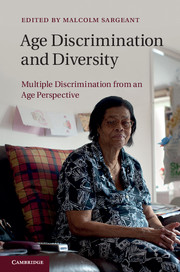Book contents
- Frontmatter
- Contents
- Figures
- Tables
- Contributors
- 1 Ageism and age discrimination
- 2 Multiple discrimination
- 3 Older women, work and the impact of discrimination
- 4 Still disadvantaged? Women in modern pension systems
- 5 Ageing and social class: towards a dynamic approach to class inequalities in old age
- 6 Age, sexual orientation and gender identity
- 7 Age and ethnicity
- 8 Disability and age discrimination
- 9 New approaches for understanding inequalities in service use among older people
- Index
- References
2 - Multiple discrimination
Published online by Cambridge University Press: 05 August 2011
- Frontmatter
- Contents
- Figures
- Tables
- Contributors
- 1 Ageism and age discrimination
- 2 Multiple discrimination
- 3 Older women, work and the impact of discrimination
- 4 Still disadvantaged? Women in modern pension systems
- 5 Ageing and social class: towards a dynamic approach to class inequalities in old age
- 6 Age, sexual orientation and gender identity
- 7 Age and ethnicity
- 8 Disability and age discrimination
- 9 New approaches for understanding inequalities in service use among older people
- Index
- References
Summary
Introduction
The term ‘multiple discrimination’ has begun appearing regularly in EU policy documents since the adoption of the anti-discrimination directives in 2000 that expanded the number of prohibited discrimination grounds in EU law from two (sex and nationality) to seven (race, ethnic origin, age, sexual orientation, and religion or belief). The 2000 Directives themselves do not contain any provisions defining or prohibiting multiple discrimination, but their preambles include statements asserting that especially women are often the victims of multiple discrimination. The 2000 Council Decision establishing a Community action programme to combat discrimination states that equality of women and men requires action on multiple discrimination, and that new practices and policies to combat discrimination should include multiple discrimination. In 2008 the European Commission announced the use of ‘new governance mechanisms to address the issue of multiple discrimination’, inter alia, ‘through . . . providing funding for smaller networks of NGOs representing intersectional groups’. In the decision establishing the ‘European Year of Equal Opportunities for All (2007) – Towards a Just Society’, the Preamble’s Recital 14 states that the European Year ‘will also seek to address issues of multiple discrimination, that is discrimination on two or more of the grounds listed in article 13 EC’.
- Type
- Chapter
- Information
- Age Discrimination and DiversityMultiple Discrimination from an Age Perspective, pp. 16 - 40Publisher: Cambridge University PressPrint publication year: 2011
References
- 2
- Cited by

